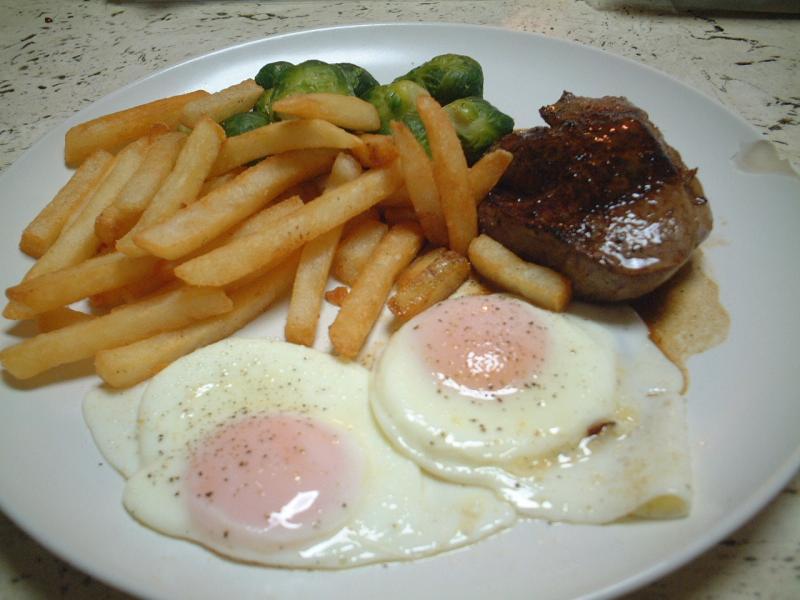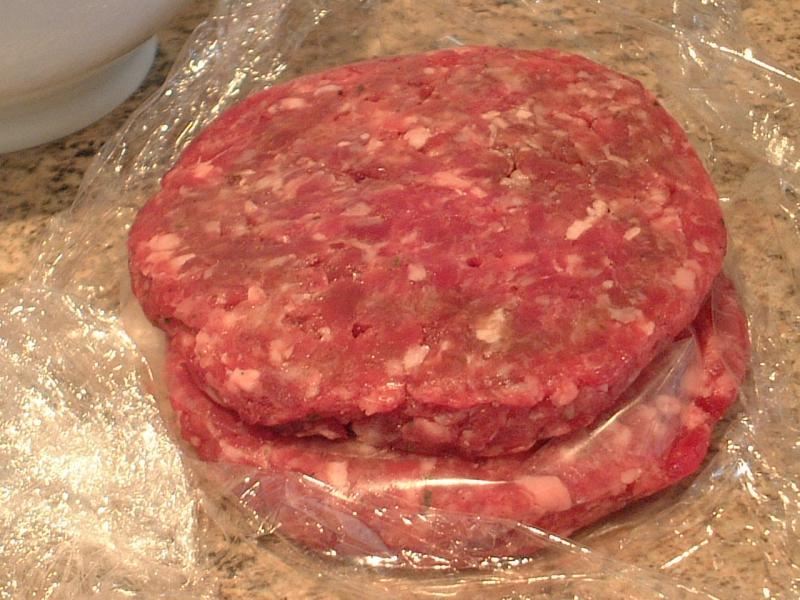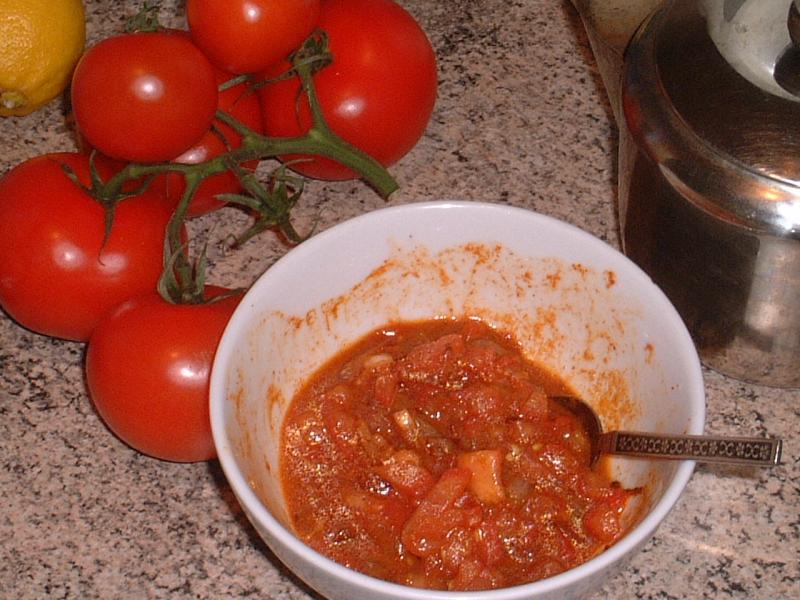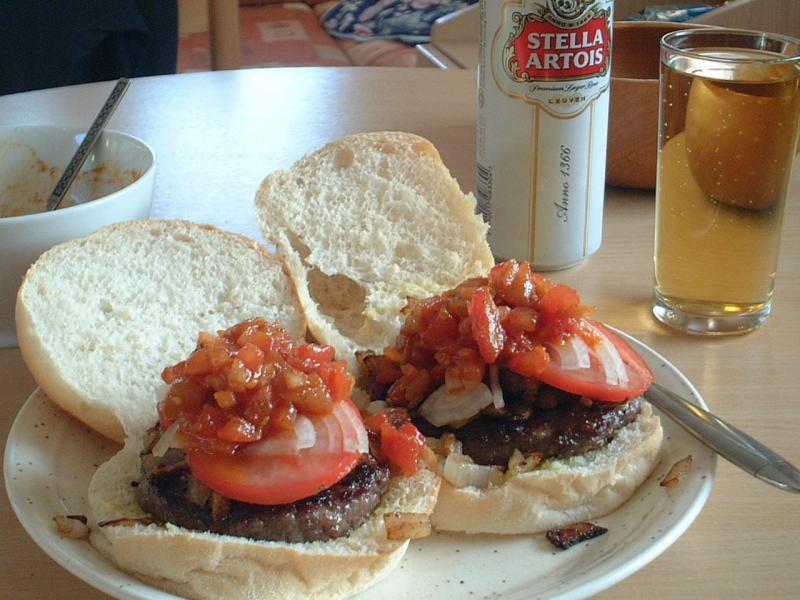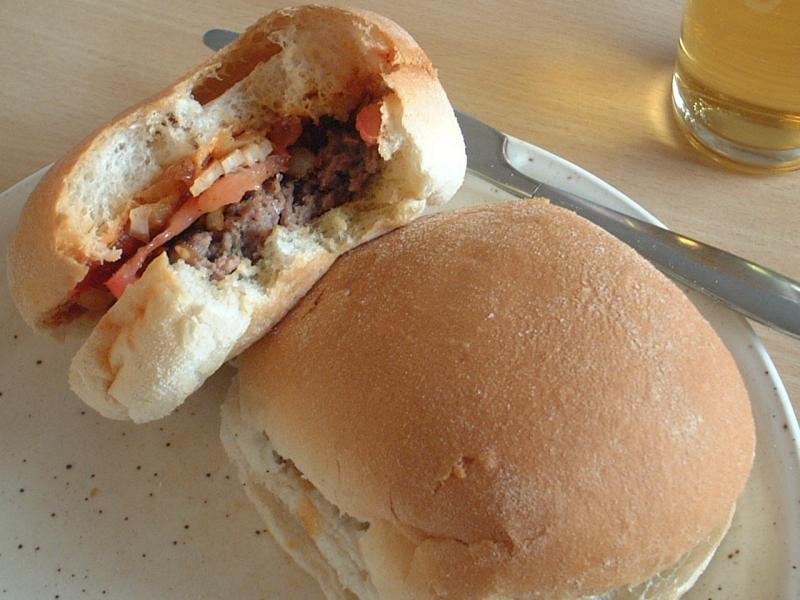-
Posts
1,728 -
Joined
-
Last visited
Content Type
Profiles
Forums
Store
Help Articles
Everything posted by Blether
-
I take a mix and match approach - most often recently, I'm wrapping a loaf in a table-linen type cloth, with the heel against the cut end. That keeps the bugs off, such as they are in winter, and the crust crusty. However, Japan's winter is dry and the bread dries out pretty quickly. If I think the loaf will be around longer than three days, I'll put it in a plastic bag - the crumb stays moist at the expense of the crust going soft. In the summer time, the plastic-bag-and-fridge comes in to play - the warm and moist air means mould. Also mixed in is occasional use of the freezer - if I'm keeping bread unused even for a few days, that's the best way.
-
It looks mighty fine. What is the method for the baps ? I've an occasional acquaintance with 'morning rolls' (as seen, for example, last week in The Bread Topic).
-
Then, yes. This is probably the single thing you can do that'll most improve the flavour. My stock cooking salt is a granular, not particularly fine salt, that I measure out by volume. One teaspoon weighs about 5 grams (my scale doesn't give me any more significant digits). My appetite for salt is about average, judging from others' enjoyment of food I cook. Whatever meat I buy fresh or defrost, I will then salt and hold in the fridge. For something like chicken legs I will use 1/4 - 3/8 tsp per lb. For boneless red meat, 3/8 - 1/2 tsp. I find this is the amount to give the 'correct' level of salt, no matter how long it soaks in (that is, it'll never be too salty even when it has completely permeated the meat). Like djyee100, I'll then add the appropriate amount of salt at each step of preparation - so much for onions, so much for other vegetables, and so on. I agree that it's important to taste as you go, and yes, be wary of reducing sauces. But try the pre-salting. I think you'll be happy with it.
-
Right. That's fascinating for me, because for one thing, it's said that the quality of cured pork depends on the quality of the source meat, and for another, that the cost of cured prosciutto takes account of the amount of the hams that spoil during the curing process.
-
It sounds like you know what you're doing, and it's always good to keep detailed notes when you're developing a recipe. Like you, I often have "thoughts for improvements" written at the end. You've already identified flavours and variations you'd like to make, so I'll just make a few brief comments. I especially like your "about 2.55 pounds" of meat, which wouldn't make it in my kitchen. That's about 2 and a half, OK ?! Likewise, I hope your 250mg of chicken stock is really 250g You mentioned "surprisingly little fat" - but you trimmed the roast, and the only other fat that went in was some olive oil. If you look at the traditional recipes like Bourgignonne, they tend to have the beef barded with fat, or some amount of salt pork / bacon melted in the pot in the initial stages. This is always something you have to balance with the fattiness of the roast itself, but it's something you might think about. Of course there are other things like trotters, bones, calf's feet, to lend richness and body. A 6-year-old Mouton Cadet is a fairly nice wine. You said you'd tried another cab that didn't satisfy. Maybe it's a big leap to go so far in search of a cabernet sauvignon that'll make a good stew ? There are those who say, using as good a wine as you can manage makes all the difference, and those who say that using a very good wine in the pot is a waste. I haven't done any all-else-equal side-by-side testing, but I can think of any number of good cabs significantly cheaper than that, all of which will make a beef/wine dish that'll have diners going "mmmmmm !". In my kitchen (again. sorry) the minimum for a good pot roast is a nice piece of meat salted correctly well in advance so the salt penetrates, some chopped vegetables, some liquid (wine or stock), other seasoning - typically pepper, bay, lemon or vinegar; initial browning and enough slow cooking without going dry. You didn't mention salting and I'm wondering, did you do that beforehand ? It's always important to taste and adjust, but it's also possible to calculate your preferred amount of salt based on the weight of the meat, and to add a minimum amount at first for the other ingredients. Lastly, when I reheat in the microwave, I typically split it into two bursts, and I'll also normally do the meat together with the sauce, because to me microwaving is a wet-cook method (and because I'm lazy at washing up). I find that if I do one continuous burst at high heat, I'm not only reheating but doing further cooking. On the other hand, if I use high heat just until the outsides of the meat are hot, the centre is still cooler. So I'll do two bursts, with a wait of 2 or 3 minutes in between. Usually I use a bowl and cover it with plastic wrap, with a small hole pierced in the centre - stopping each time when the wrap has ballooned up with steam for a while. Edit to add: oh yes, and by "browned the roast over medium low heat for 30 minutes on a side" Did you mean you browned the roast for 30 mins on four sides, i.e. you browned it for 2 hours ? Or something else ?
-
That sounds like quite a success. What was the source of the pork legs / how particular were you about it ?
-
Thanks, Nayan, that's helpful. I guess I have some time to buy a second container and make up the water. Sweet doesn't sound so good.
-
Mmm. Now you're being silly. Edit To Add: did you see this report of Andrew Hamilton in New York subbing beef liver for lamb lung ?
-
Well, I have a batch of ginger wine bubbling away. Saturday, I thought I'd make double the recipe, maybe having to discard the last pint or so of mixture, depending on how the '8.4L' container worked out. Anyway, my stockpot is stamped "7 (US) quarts / 6.6L", so I started out with all the sugar, ginger and lemon zest, and as much water as would fit, and boiled for an hour. I first chopped the ginger in lumps of about 3/8", put it in a plastic bag and bruised it in a friendly manner with a claw hammer held sideways. There was no scum. I quickly cooled this stockpotful to lukewarm (thermometer checked at ~31C) in a sinkful of cold water, poured it directly into the fermenting bottle, and added 1/4tsp of Saf-instant dried yeast. The ginger floated throughout the boiling period, and remained floating in the fermenting bottle. I then boiled another batch of water in the unwashed stockpot, again cooled this (29C before I even first measured) and added as much as I could to the fermenting bottle. It had become clear when I measured the water going into the first potful, that there was going to be quite a lot left over, not just a pint or so. Of course the recipe's "makes 4.5L" doesn't seem to take account of the volume of the sugar, in particular... or is 'simmer' supposed to mean 'boil furiously' ? Or will the volume lost in decanting & bottling leave a '4.5L' final yield ? In the end, where the recipe calls for 16 (British) pints of water for a double batch, I could only fit 11.5 pints in total - 72% of the water called for. The ginger and the yeast that had been floating on the surface sank like stones when I poured in the additional water. There was no discernible yeast activity, no frothing, not even a bubble and I was concerned that things weren't going to work out. Anyway I covered the opening of the bottle with a cloth and left it overnight. On Sunday, I still saw no activity, and added just a pinch (less than 1/8tsp, I'm sure) more dried yeast, before chopping the raisins and adding these and the lemon juice, stirring everything briefly and sealing the bottle with its lid. This morning I stirred again briefly, and sat the bottle in front of the gas fan heater for a while. In a short time I could see distinct gassing, and I think this proportions-skewed lot of ginger wine is on its way to becoming... something. There is no hiss of escaping gas when I loosen the lid, so I believe the pressure-relief valve is doing its job. I have questions. How will the higher concentration of sugar affect this wine ? Will it likely end up sweet with the yeast dying early, or strong, or something else ? Why does the recipe ask for the - what's the correct word for the mixture, anyway ? wort ? - the mixture to spend a night in a bowl before transferring to the fermenting vessel ? Why hold off on putting the raisins and lemon juice into the mix ?
-
Ooh, Kim. I think it's the chicken fat that made them extra good. Starting-from-cold was just what seemed convenient at the time, but yes, a lower-temp initial fry is one way to vary the approach; the buzz these days is triple-cook (parboil, low temp parfry, fry), isn't it ? Which look great. I don't have a basket in my deep-fry pan, so with chips cut from raw potato I content myself with a pre-boil or steam and a single fry. That's is much better than just frying once at high temp, and can perhaps be improvised in oil the same way I did yesterday, if you've a powerful enough burner for the amount of chips/oil you have (come to think of it, the prep of chips in a frying pan with just enough fat to cover worked pretty well). Identifying floury potato varieties is the other challenge that works against chips-from-raw here, where potatoes are labelled either 'potatoes' or 'new potatoes' (or cutely in my local store last year, in English, "New Thing Potato"). Edit: because I forgot to ask, what's your English step-dad's sprout method ?
-
This is good advice. My end-grain maple board (price was a consideration) is 1 1/4", and that's working out. Custom-made, my choice would be something like 1 1/2" to 2". These thicknesses are for my board size of 14" x 18". Required thickness will vary with size. As an alternative perspective, I'll offer that rubber feet make it harder to use both sides. I like the fact that I've a groove on one side to catch liquid run-off, which is good both for wet raw stuff like tomatoes or certain meats, and (well washed, of course) also for carving roasts. It is a good idea not to have the board sitting in water. I keep mine stacked on end when not in use. And yes, listen to the woodworker on wood choice. I think you'll want to have well-seasoned stock, whatever type it is, and what's available might even mean that that's a higher priority than free choice of types.
-
Oh, and - - I think wet-climate sheep are traditional, leastways all the loaded sheep trucks I ever saw were headed south.
-
Nice-looking keema, Bruce. More interesting than many, visually, and in the eating too, I expect. I had a steak that came out of the freezer to make room for other stuff and needed eating, but no spuds. I went out to buy eggs for breakfast, but the spuds in the shop didn't appeal. In the end, an untraditionally rare steak as part of traditional steak, egg & (chicken-fat-fried) chips: Frozen chips - you must be messing with my mind, Kim. Still, that means even more freezer space. I skimmed the chicken fat off a stock ten days ago or so, and the steak has just a little white-wine reduction mounted with butter, to underline its individuality. I broke some people's most-cherished rules by laying the frozen chips into the congealed fat in the frying pan (spatter's a drag), bringing it up to what must have been 120-130C or so fairly quickly, turning down the heat for 5 or 6 minutes to cook them through, then bringing it up again to finish them off. They're never this golden, crunchy and delicious when I use deep oil. (Special for Judiu: more chips on this plate than you can poke a stick at).
-
:laugh: Each new generation - hell, each individual - must rediscover its / his / her own heritage, wouldn't you say ? The same stuff fascinates me, too. It must be the long winter evenings. I'm sure you're aware of the background, but for the sake of completeness I'll offer some thoughts on Scotland's national dish. The obvious genesis of this is, I believe, Burns' 1786 poem, and his adoption as the national bard. Not available in my area - it may be in yours - you can find one copy of the text at least at the BBC, and if you're lucky hear it read by John Gordon Sinclair - Gregory, no less. It's my belief that that adoption of Burns was a spontaneous result of the widespread acclaim in Scotland that met the publication of his first verse collection. There's a longish but exceptionally good article on Burns - Freedom and Houghnamagndie - by Andro Linklater at The Spectator Book Club. Forgive me for overdoing the quotations: (on Burns) (on the published work) Of course Scotland's national failure in Panama and rescue through 1707's union, the decline in clan power after the Jacobite defeats of 1715 and 1745, and the advent of a new anglo-centric gentry immediately precede and coincide with Burns' time. It was the famous Highland Clearances that saw crofting communities displaced by sheep, so that perhaps the increasing ubiquity of lamb and mutton in Scotland combined with these other developments gave us the Haggis we know today. I don't think haggis is understood in any detail by the general public, even in Scotland. Generally everyone relies on the butcher trade, or on volume producers like Grant's (tinned haggis). Just as you say, you can go through life noticing when you're served particularly good haggis, and if you care to ask where it came from, then knowing a good source - but what part of the sheep's intestine was involved, or how the farce was created is something you'd need to take some trouble to find out. The number of people making the stuff at home has to be vanishingly small. My own Holy Grail of haggisdom is the haggis I remember from "McDougall's the butcher". Fortunately for me the core staff now work at the remaining butcher in my home village, so when i get back there I can still get pretty much exactly that (already seen in the Dinner! thread at least). For a St Andrew Society event in Tokyo we had haggis made up from scratch by the French chef at one of the hotels in town - he made a good job and our Burns Supper guests loved it, even if it was heavier on the cinnamon than is typical, and wrapped in crepinettes rather than gut.
-
Paul, You also asked "Are those the names used in the UK market as well?" - I've been out of the country for nearly 20 years, and never went down the 'make your own haggis' road while I was there, so I'm afraid I can't answer that any better than anyone else with the use of Google. I'm intrigued with the depth to which you're going into things. - and by your comment on seasonings. I'd not seen cayenne or lemon juice in a haggis recipe, that I remember, till the Dods one. Of course it fits entirely with the basic principles of seasoning to have something sour in the mix. Likewise the suet - I mean I'm likewise intrigued. Did you look at the very early recorded recipes for 'Hagese' &c per Wikipedia ? To what extent do you care about authentic in method & materials, as opposed to authentic in terms of flavour / eating qualities ?
-
No problem. It was jackal10 who brought up the Dods book, in the Old Scottish cookbooks thread. I guessed from - - that she means a sheep-gut bag rather than something manufactured. Maybe her easy way with the calling for it reflects how readily available a 'haggis bag' was to her. Best of luck with your haggis, and I hope you'll post more about it.
-
Yes, if you have a bunch of those, cooking various different varieties in the same pot becomes a real possibility.
-
Hi, Paul. As an expat Scot I'm always interested in haggisery, particularly given that the country I live in banned meat imports from the UK in the 50's and has kept it that way ever since. I'm sorry I can't answer your first question directly, but maybe I can help a little bit. First of all, two sources you may have read already. I seem to be linking to it in every other post having first read it recently, but 'Margaret Dodds' addresses the subject of haggis at some length in her 1829 book - read from page 354 at Google books - the 'contents' tool will get you there quickly. The second piece is Tim Hayward's article and guide in The Guardian a year ago. Tim says, On the same subject, 'Margaret' aka Isobel says, ahem, - so there's that. But further on she more usefully suggests: and Don't miss the calf's haggis explained in the footnotes, either.
-
Stew and braise are good suggestions, I'll second those. You don't want to fast-cook the shoulder meat in a piece; I think approaching venison the same way you'd handle lamb is a good rule of thumb. You could also grind the meat and have some really delicious burgers (add fat if the meat's too lean): I picked these ones up from the butcher when I was in Scotland last summer: and cobbled this salsa together for them: "That's a tasty burger !"
-
Hi, Nakji. I don't remember butter icing ever needing that much beating, and doesn't it soften up pretty quickly once you mash it a little ? Otherwise, how about leaving the butter in some warm(er) water to soften up ?
-
I surprised myself tonight by pickimg up one of these: an 8.4L 果実酒びん / kajitsushu-bin, aka 'fruit liquor bottle'. It's polyester, has a good wide opening and a lid with a built-in pressure relief valve and a sub-opening for pouring that has its own screwtop, and it cost all of 980yen. Eat your heart our, Mrs. Beeton. It's also on page 35 of the maker's catalogue, or see this Google search, which for the moment at least returns product pages on both Rakuten and Amazon, amongst other things. On the label it proudly proclaims in English, "Pack in Heaps with compact size ! Light but sturdy !", and can only say I am totally down with that. So... by coincidence I'm on the point of re-stocking on ginger. I'll add plenty of sugar, some raisins and a lemon to the list, and get cracking.
-
I may not know much, but i know how I like my egg fried Bacon is never ordinary. Are those burgers or sausage ?
-
That pizza really does like nicely done, Maple1, particularly for first-in-the-new-oven. It's not your first ever pizza, is it ? emmalish, the more pictures the better. How do you feel about the results from your new camera ?
-
Yup, roast it. I love crispy duck n' pancakes n' plum sauce when I eat at a Chinese place that does a good job of it, but haven't tried it at home. I find I'm happy with a pre-salt and simple roast - we had duck a few times as Christmas dinner for two (Christmas isn't a trad family get-together in Japan, and my wider family being far, far away). All that fat in the bird, nice tasty meat - what more do you need ? Fridges are dry inside - if you choose to go simple, just rub in enough salt for your taste, and leave it in there uncovered, say overnight, on a rack of some sort. One thing you might consider, if you're not too fussy about a whole-bird presentation, is to detach the breast section (in one piece, on the bone) before roasting, so you can lift it off when it's done - the challenge always seems to be to cook the legs just right before the breast is getting dry and tired. 'Course you can cut the breast off once you've cooked it that far, but you might find it easier while it's cold.



